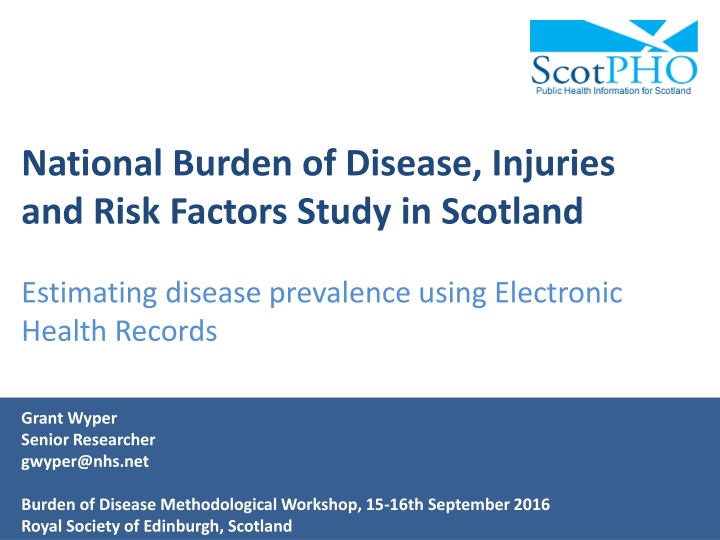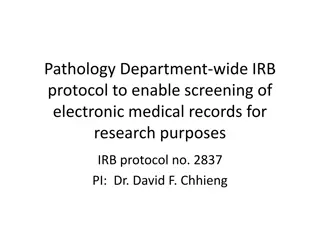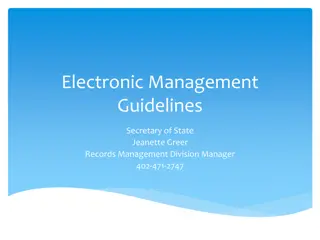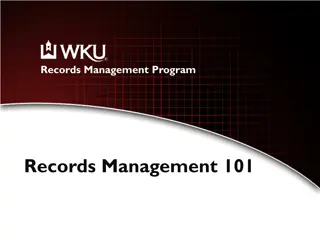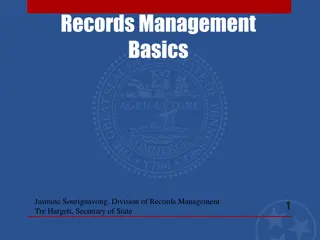Utilizing Electronic Health Records to Estimate Disease Burden in Scotland
The Scottish Public Health Observatory is leveraging detailed Electronic Health Records (EHRs) to estimate the burden of disease in Scotland. By tapping into a wealth of EHR data on various health indicators, the study aims to provide a comprehensive analysis of non-fatal and fatal conditions. Main deviations from the Global Burden of Disease 2013 estimates include a focus on symptomatic populations and rescaling severity distributions to capture accurate health state prevalence.
Download Presentation

Please find below an Image/Link to download the presentation.
The content on the website is provided AS IS for your information and personal use only. It may not be sold, licensed, or shared on other websites without obtaining consent from the author.If you encounter any issues during the download, it is possible that the publisher has removed the file from their server.
You are allowed to download the files provided on this website for personal or commercial use, subject to the condition that they are used lawfully. All files are the property of their respective owners.
The content on the website is provided AS IS for your information and personal use only. It may not be sold, licensed, or shared on other websites without obtaining consent from the author.
E N D
Presentation Transcript
Scottish Public Health Observatory logo National Burden of Disease, Injuries and Risk Factors Study in Scotland Estimating disease prevalence using Electronic Health Records Grant Wyper Senior Researcher gwyper@nhs.net Burden of Disease Methodological Workshop, 15-16th September 2016 Royal Society of Edinburgh, Scotland
Background GBD 2013 published estimates for Scotland do not take into account routine reported statistics on health in Scotland Scotland has a wealth of detailed Electronic Health Records (EHRs) Structured data on health activity at patient level available in some instances for > 35 years Aims to utilise our country-specific EHRs to estimate the non- fatal and fatal burden of GBD 2013 conditions and health states
EHRs in the Scottish Healthcare System Age Gender Area of Residence Deprivation Urban/Rural Migration Wide range of EHRs available on contacts with health and social services Individuals Unique patient identifier widely available Cancer Registry Diabetes Register Learning Disability Statistics Scottish Health Survey Datasets can be linked to search for clinical contacts indicative of patient burden in an extensive manner Other Primary Care GP Consultations GP Disease Registers Community Prescriptions Dental Treatments Surveillance of Communicable Disease Demographic available, so sub- national analysis is available and representative Age-group and Gender Deprivation Local area Secondary Care General and Psychiatric Hospital Stays Outpatient Appointments Intensive Care/High Dependency Unit Stays Unscheduled Care Birth Records Maternity and Neonatal Care
Main deviations from GBD 2013 Reliance on severity distributions to capture health state prevalence Use of EHRs are usually indicative of symptomatic population Rescaling of some severity distributions to remove the asymptomatic health state YLD still comparable, but not prevalence Health Impairments estimated for Scotland Heart Failure (clinical history of EHRs) Epilepsy (clinical history of EHRs) Intellectual Disability (Learning Disability Statistics Scotland) Anaemia (clinical history of EHRs) Infertility (clinical history of EHRs) Vision and Hearing Loss (clinical history of EHRs)
Preparation Examination of coding systems for structured data ICD 9, 10, O, O2, O3 OPCS-4 READ codes British National Formulary Bespoke systems (Statement of Dental Treatment, Surveys etc.) Primary clinical expert review of conditions and health states Data access and permissions for data linkage Creation of master file with the ability to exhaustively search for a defined condition across several datasets for each patient Coding of analytical programs to analyse and output estimates
Estimating Prevalence Allocation to disease list are based upon code lists Prevalence lookback period on historical EHRs 1-20 years Removal of deaths and patients that have migrated Exclusion of incoherent/miscoded records e.g. Males coded under Female Infertility Males coded under Spontaneous Abortion Prospective search of a patient s clinical history following a subjective diagnosis that falls into an Other dump category Confirms if a timely diagnosis to a target cause has been made Avoids over estimation of YLD
Disease Models Time-related disability: Acute stage Appendicitis Long-term disability: Chronic stage Musculoskeletal Disorders Hybrid: Acute and Chronic stage Stroke Injuries (Long and short-term) Using EHRs beneficial under hybrid model as disability can be adjusted by constructing patient pathways through health Willingness to make more use of the hybrid model amongst clinicians Pancreatitis (lack of DWs for acute and chronic condition)
Injury-Specific Model Short-term Health Loss Long-term Health Loss YLD = [Incidence x DWST ]+ [Prevalence x P(LT outcome) x DWLT] ST Short-term; LT Long-term Linkage of accident and emergency attendances to inpatient/day case hospital datasets for injury follow-up Each injury assigned an element long-term health loss, rather than randomly simulating whether or not each injury should be assigned long-term health loss Outpatient data doesn t have sufficient clinical coding Patients without an inpatient stay follow outpatient probability
Adjusting for Uncertainty Recognition that there are some conditions that can t be fully captured using EHRs e.g. Alzheimer's disease and other dementias Low back and neck pain EHR estimates to be corrected using a prior distribution to describe the gap between the EHR estimate and expert opinion or published information Simulation methods applied to output prior-informed estimates Prior distribution selection, unadjusted and adjusted prevalence estimates will be published for transparency
Overview of Process Patient Linked EHRs YES NO Diagnostic Agreement Disease Health State(s) Disease Published Surveys/Literature Estimate Missing DHS Draft Prevalence GBD Severity Distributions REVIEW ASSUMPTIONS Clinical Review EXPERT AGREEMENT Final Prevalence Sub-National Geography Gender Age Deprivation
Prevalence Results: GBD 2013 vs. Scottish EHRs Table: Prevalent cases in Scotland for selected conditions Disease GBD 2013 Scottish EHRs Low Back Pain 256 000 458 000 Ischaemic Heart Disease 111 000 225 000 Atrial Fibrillation 15 000 55 000 COPD 358 000 138 000 Asthma 256 000 314 000 Alcohol Use Disorders 58 000 115 000 Cirrhosis 2 000 28 000 Diabetes Mellitus 198 000 254 000 Major Depressive Disorder 150 000 121 000 Breast Cancer 30 000 48 000 Colon and Rectum Cancer 15 000 28 000
The Other Category GBD 2013 cause list contains many other categories within the wider disease groups Other MSK disorders Other neurological disorders Other cardiovascular and circulatory diseases Issues with non-specific recording of disease on EHRs Codes are sometimes too vague to link to health state or a target disease Can lead to over-estimates of other disorders GBD 2013 computes the YLD:YLL ratio of the cause-specific related diseases and then multiplies the other YLL group to derive YLD for the other groups Replicating this approach gives YLDs more comparable to GBD 2013
Future Research Development of new national datasets Laboratory Tests Results Local specialised healthcare and social service data Explore use of large consented cohorts e.g. UK Biobank Coding of unstructured data Initial reason for visit at Accident and Emergency Dose instructions for community prescriptions Increased effort to estimate health state prevalence to remove reliance on GBD severity distributions
Scottish Public Health Observatory logo Discussion Disparities in approach: EHRs and Modelling Overcoming the reliance on severity distributions Disease models Prior-informed adjustment Collaboration Prevalence Estimation
